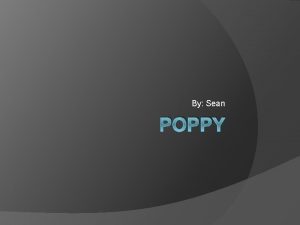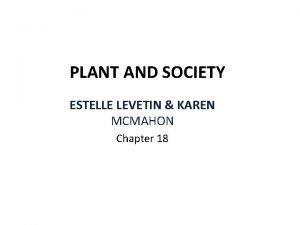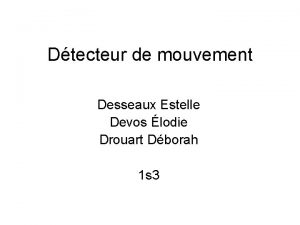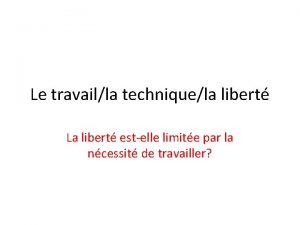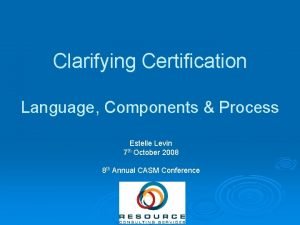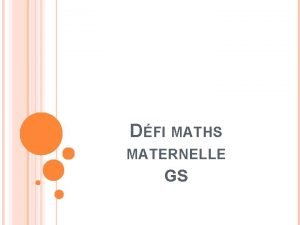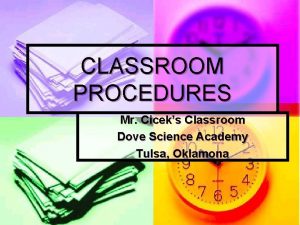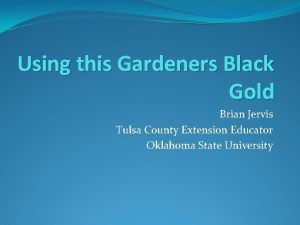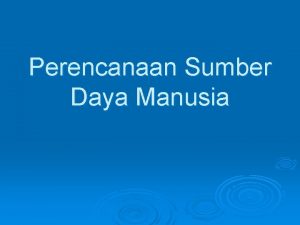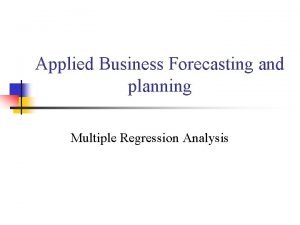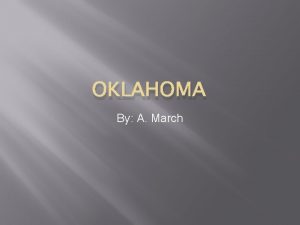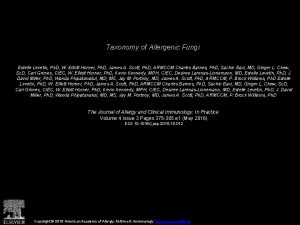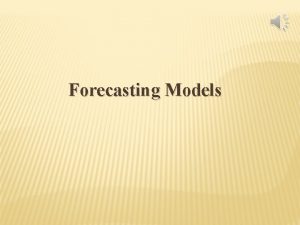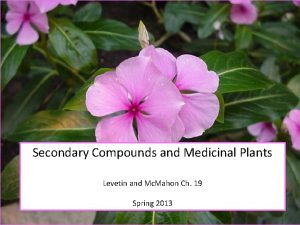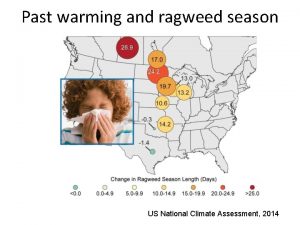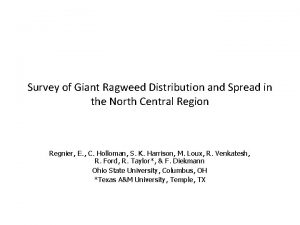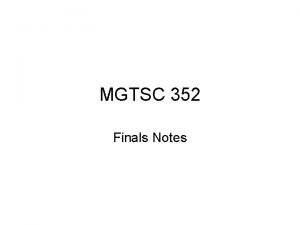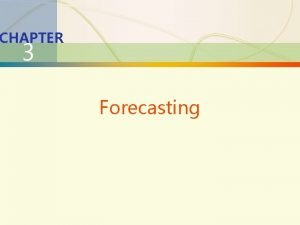EVALUATION OF RAGWEED FORECASTING IN TULSA Estelle Levetin
























- Slides: 24

EVALUATION OF RAGWEED FORECASTING IN TULSA Estelle Levetin, Ph. D The University of Tulsa

Ambrosia Pollen • Most important pollen allergen in N. A. • In Tulsa area, cumulative Ambrosia pollen is first or second in terms of yearly abundance • The ability to accurately predict day to day pollen levels could provide important benefit to sensitive individuals either by avoidance or by taking prophylactic medication

Stand of Ambrosia trifida along the east bank of the Arkansas River

Flowering in Ragweed • Controlled by photoperiod • Pollination is the same time each year at a given location unless stressful climatic conditions influence growth and reproduction in the plants. • Once pollination begins, pollen release and atmospheric pollen concentrations are influenced by meteorological conditions.

Pollen Forecasts from TU • Multiple regression models • Empirical model for mountain cedar pollen release coupled with HY-SPLIT dispersion model • Development of ragweed forecasts – Empirical Model – Ragweed Pollen Forecaster (computer software) generated by 6 students from Dept of Computer Science (Cyber Corp)

Air Sampling • Burkard Spore Trap has been used for air sampling in Tulsa since Dec. 1986 • Ragweed data from 1987 to 2001 was used to determine pollen season characteristics – Start date - 5% of season total) – End date – 95% of season total – Typical peak date


Pollen Season Characteristics • Mean start date (5% of season total) – 27 Aug • Mean end date (95% of season total) – 11 Oct • Mean peak date – 10 Sep

Empirical Model • Pollen concentrations compared with data from the National Weather Service to determine the effects of meteorological conditions on airborne pollen levels • Empirical model was developed based on phenology and the weather forecast • NGM-MOS 60 hour forecasts were used • Model was used to generate pollen forecasts for the 2002 and 2003 ragweed seasons • Comparison with the atmospheric ragweed pollen concentrations was used to evaluate the model

What conditions trigger pollen entrainment? • • No rain Sunshine Low humidity (below 75%)? Moderate to high wind speeds Afternoon temperatures below 95 o. F Morning temperatures above 65 o. F Phenological phase

What are Low, Moderate, High, and Very High Values? NAB* 1994 AAAAI Pollen and Spore Report Tulsa Model Low Moderate High Very High 0 -50 th 50 -75 th 75 -99 th >99 th NAB Concen 0 -9 10 -49 50 -499 >500 Tulsa Concen 0 -129 129 -284 285 -613 >613 Percentile 0 -50 th 50 -75 th 75 -90 th >90 th Tulsa Concen 0 -129 129 -284 285 -410 >411 Percentile Goal 0 -25 th 25 -50 th 50 -95 th >95 th Actual Percentile 0 -27 th 27 -47 th 47 -95 th >95 th 0 -49 50 -99 100 -489 >490 Percentile Concentration *Burge, H. A. 1992. Monitoring for Airborne Allergens. Annals of Allergy, 69: 9 -18


Forecasting Model • Phenology Factor (PF) – based on day in the pollen season and 15 year mean concentration (Range 1 to 6) • Metereological forecasts from NGM-MOS 60 hr forecast v R – forecast of rain (- variable amount) v T – temp outside optimum range (morning temperature < 65 F or afternoon temperature > 95 F) (- variable amount) v RH – forecast of noon relative humidity >75% (-1) v W-sp – wind speeds >15 mph (+1) v W-dir – wind from N - Aug 15 -31 or wind from S - Oct 1 -31 (+1) v Pre – Preseason weather – hot, dry July and August (-1) Forecast = PF – R – T – RH + W-sp + W-dir – Pre






NAB Pollen Categories Forecast Pollen Level Low Moderate High Very High Number of Days LOW 28 9 3 LOW TO MODERATE 11 16 7 MODERATE 2 3 7 MODERATE TO HIGH 15 HIGH 16 1 HIGH TO VERY HIGH 14 2 VERY HIGH 5 1

Ragweed Pollen Forecaster


Computer Program Evaluation • Correct forecast 34 days (49%) • Incorrect forecast 13 days (19%) • No forecast data 23 days (32%) – For the 47 days with data: 72% correct

Conclusions • Empirical model accurately predicted the pollen level on 84% of the days during the 2002 and 2003 ragweed seasons (74% using NAB levels) • Computer program needs more work • Pollen forecasts are only as accurate as the meteorological forecasts • More research is needed on the – effects of RH and rain on pollen release and dispersal – influence of pre-season meteorological conditions on the seasonal pollen potential

Acknowledgment The assistance of Claudia Owens, Shernell Surratt, and Christen Townsend in counting pollen is greatly appreciated.
 Ragweed by avi lesson plans
Ragweed by avi lesson plans Levetin
Levetin Estelle setan national treasury
Estelle setan national treasury Estelle millet
Estelle millet Estelle devos
Estelle devos Estelle libert
Estelle libert Estelle levin
Estelle levin Estelle v. gamble
Estelle v. gamble Jacques murphy pagnol
Jacques murphy pagnol Estelle malaquin
Estelle malaquin Estelle v. gamble
Estelle v. gamble Estelle oldham jill faulkner
Estelle oldham jill faulkner Patton dumpster
Patton dumpster Osu radiology tulsa
Osu radiology tulsa Multiclean tulsa
Multiclean tulsa Tulsa adventist academy
Tulsa adventist academy Dr christopher browne tulsa ok
Dr christopher browne tulsa ok Brant and associates
Brant and associates Osu extension tulsa soil testing
Osu extension tulsa soil testing Tony jabbour
Tony jabbour Tulsa church of god
Tulsa church of god Tracking signal forecasting
Tracking signal forecasting Penyebab permintaan sdm
Penyebab permintaan sdm Collaborative forecasting in supply chain
Collaborative forecasting in supply chain Durbin watson test interpretation
Durbin watson test interpretation
